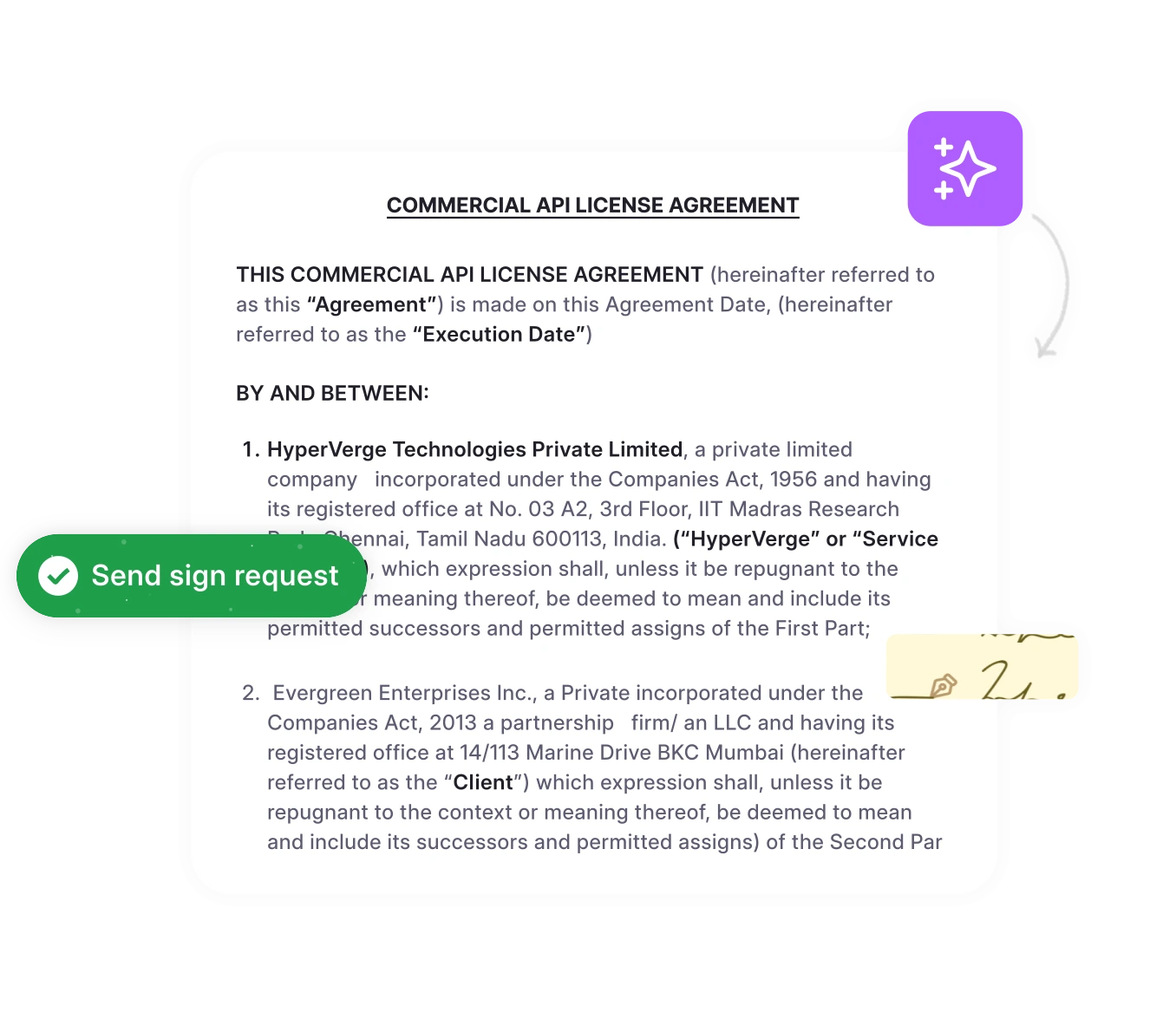Contract management tools: An introduction
Contracts are the lifeblood of every business. They are the cornerstone of customer, vendor, partner, and employee relationships. Businesses increasingly depend on relationships to lower costs, improve quality, and drive innovation. But traditional contracts just don’t cut it. They erode the professional trust needed to navigate external volatility. According to IACCM, poor contract lifecycle management can cost your company:-
-
- 9% of your annual revenue
- 5–40% of deal values
-
-
-
- 50% decrease in contracting time
- 25-30% cut in admin overheads
- 55% boost in compliance
-
What do contract management tools do?
“The six principles—reciprocity, autonomy, honesty, loyalty, equity, and integrity—form the basis for all contracts.” A New Approach to Contracts, HBR
Have you ever missed a deadline or fallen prey to a costly auto-renewal? Keeping up with all your contract obligations calls for a specialized tool to do the job for you. A contract management solution streamlines contracting, simplifies partner relationships, and benefits businesses of all sizes. Based on your industry, process, and requirements, you can choose and customize your CLM tool. If you’re a small or medium-sized business with contracts across multiple email threads, devices, and folders or a more enterprise firm with a handful of spreadsheets to manage your contract data, we know the struggle is real. It’s time to shop for a CLM tool.Why contract management tools are important
1. One centralized repository:
A contract repository solution is a unified source of truth with quick and organized access to all digital and legacy contracts. This eliminates the hassle of manual searching across multiple devices, folders, and data sources and ensures data consistency.2. Enhanced visibility & control:
A contract obligation tracking solution provides visibility and control by a single storage repository that is secure, searchable, and organized. This enables easy access, search, and analysis while fostering transparency and control over the entire contract lifecycle.3. Workflow efficiency:
Automating contract workflows is a game-changer. It streamlines the entire contract lifecycle from creation, approvals, and negotiations until the deal is closed. This saves time, reduces the risk of errors, and frees up legal teams to focus on more strategic matters.4. Risk mitigation:
Legal teams can identify, flag, and proactively plan against risks and costly disputes by ensuring compliance with regulatory protocols and internal policies. A contract risk management solution tracks and monitors obligations, deadlines, and renewals in real time, reducing the likelihood of compliance issues.5. Improved collaboration:
Collaboration among legal, procurement, and other departments among both in-house and counterparty teams is significantly enhanced. A contract management solution fosters seamless communication, aligns a cadence that guarantees control, reduces bottlenecks, and makes sure that every stakeholder is on the same page throughout the contract lifecycle.6. Data-driven decisions:
A contract management solution tracks and monitors valuable data and analytics, enabling legal teams to make informed decisions based on real-time insights. These can track contract performance, identify bottlenecks, and optimize contract management processes flow. A good contract lifecycle management software specifies the goals of every stakeholder and establishes governance structures to keep every party’s expectations and interests aligned over the long term. Great CLM tools don’t just happen. Just as great relationships don’t just happen, they are designed from the outset, with the basic principles of all contracts: “reciprocity, autonomy, honesty, loyalty, equity, and integrity.”The challenges around contract management tools
Traditional methods of contract management often fall short of addressing the complexities of modern business agreements. Manual processes are prone to errors, delays, inconsistencies, siloed data, and lack of visibility, which can lead to missed deadlines, costly auto-renewals, non-compliance issues, and potential financial losses.1. Change management:
In a dynamic business environment, a CLM tool change can be tedious and risky without the right strategy. It demands identifying, planning, implementing, and managing modifications in the cultural and procedural shifts that may face resistance from any of the stakeholders.2. Data migration & implementation:
Transferring existing contract data to a new system can be both time-consuming and error-prone. It may require uploading contracts from multiple sources across digital, legacy, and scanned archives and data cleansing for accuracy.3. System integration:
Integrating a contract management solution with an existing enterprise system, such as ERP or CRM, can be complex. Most CLM tools already have pre-built integrations, but you’ll need to find one that fits more naturally with your processes. This is crucial for ensuring compatibility and optimizing workflows across sales, finance, HR, procurement, and leadership teams, both in-house and external.4. User adoption:
Resistance to change and inadequate training can hinder user adoption. Legal teams need to invest in comprehensive training programs to maximize all the benefits a contract management solution can offer.5. Customization complexity:
Some contract management tools can pose challenges in terms of customization. Legal teams need tools that can adapt to their unique contract management process flow without extensive technical know-how.Fun fact: Economists identify shading as an important problem in all contractual relationships. Shading is retaliatory behavior in which one party stops cooperating and stops being proactive, or makes countermoves. This happens when they aren’t getting the outcomes they desire or feel the other party has not been reasonable, sometimes this behavior happens even unconsciously, to compensate.
Essential features in CLM tools
Among the many factors to evaluate are functionality and flexibility. These aspects vary vastly based on your business model and requirements. Before you decide, make sure you know what you need. Take time to try them out so you know how steep the learning curve is.1. Create:
“The clearer the contract, the shorter the dispute.”
Paul Belleflamme
A robust contract creation solution should provide simple, clear, and intuitive templates for users to draft contracts easily. Browser-based templates, device-uploaded PDFs, scanned copies of legacy contracts, clause libraries, and collaboration features streamline the process, ensuring efficiency. They can also ensure accuracy through OCR capabilities.2. Approve:
Have you ever accidentally emailed a colleague an older version of a contract? Or have you mistyped a stakeholder’s email and they didn’t receive the contract at all? You’re not alone. Efficient approval workflows facilitate seamless collaboration among stakeholders and allow quick reviews, comments, and approvals. Clear contract automation approval paths put you back in control, enhancing visibility, and reducing bottlenecks so you always know who has the pen and who has to sign.3. Negotiate:
“Only free men can negotiate; prisoners cannot enter into contracts.” Nelson Mandela
Advanced contract negotiation tools empower users to collaborate on contract terms in real time with features like version tracking and in-document commenting to simplify the negotiation process and foster collaboration among all parties. This feature frees up your time to think about a deal more strategically instead of sweating the small stuff.4. Store:
Security and accessibility of contracts is more than about archiving papers. They are built on a foundation of trust. A CLM tool should offer a secure and organized contract repository for all contracts and associated documents, ensuring easy retrieval and compliance with data security and regulatory standards.5. Track:
Without contract analysis, both your organization and counterparties are like ships at sea without a compass. The true success of your business partnership lies not in signing a deal but in the tracking and fulfilment of your obligations. Comprehensive tracking capabilities are vital for monitoring the contract lifecycle in real-time. Users should be able to track key milestones, contract status, deadlines, performance metrics, and upcoming actions, facilitating proactive management, mitigating risks, and maximizing opportunities.6. Sign:
The pen is the first act of commitment that bridges intentions and actions. Contract signing software expedite contract execution with secure electronic signature integration. Advanced tools are also compliant with Aadhar and e-stamping protocols. This feature eliminates the need for paper-based signing, reduces delays, and ensures compliance with industry standards and legal requirements.7. In-flight dashboard:
The in-flight dashboard helps you track real-time data and pulse of your contracting productivity. It provides a comprehensive overview of all ongoing contracts pre-execution. It displays key metrics such as number of turns, current turn, and total review time to optimize workflow processes and close deals faster.zThe common triggers for change
Each business has its own distinct characteristics. There could be various reasons why you need a new CLM tool. Take time to reflect on whether the current circumstances truly warrant the adoption of a new system by consulting with your teams. Ask them if any of these situations resonate with their experiences:-
Your teams operate from multiple sources of truth.
-
Your legal, sales, finance, and procurement teams work in silos.
-
Your drafting, approvals, negotiations, tracking, and signing happen manually.
-
You’ve identified expensive gaps in your contract management process.
Best practices when choosing contract management tools
Shopping for a contract management solution is like shopping for a home. You will need to evaluate it and compare options, features, and prices before you make the buying decision. In today’s business climate, legal teams are under immense pressure to manage a growing volume of contracts effectively. To make sure the implementation is successful, legal teams should carefully plan and adhere to the best practices in the industry.1. Define clear objectives and goals:
Before embarking on implementing a CLM tool, it is crucial to establish clear objectives and goals for the project or the organization at large. This involves understanding the current challenges the legal team is currently experiencing while managing their contracts and identifying desired outcomes. A clearly defined objective guides the selection process, ensures alignment with organizational goals, and provides a contract management framework for measuring success.2. Consult key stakeholders:
Legal teams should collaborate with professionals from procurement, finance, sales, HR, and other relevant functions to gather multiple perspectives. This collaborative approach ensures that the CLM tool aligns with the broader organizational goals, addresses respective concerns, ensures buy-ins for the project, and tailors an effective contract management solution that meets the needs of diverse teams at once.3. Conduct a thorough vendor evaluation:
The market offers an array of contract management tools with various capabilities and features. Selecting the right CLM partner requires a thorough evaluation of the industry’s expertise, ease of integration & use, product capabilities, vendor experience, customer reviews, scalability, and customer support capabilities.4. Establish data governance policies:
Data requires robust governance policies to ensure accuracy, security, and compliance. These policies must address and safeguard data retention and disposal practices to ensure compliance with data privacy laws.5. Access comprehensive training programs:
To make sure every stakeholder adopts and utilizes the CLM tool to its fullest capacity, legal teams should collaboratively offer comprehensive training to all users with the CLM partner. The knowledge transfer must include system features, functionalities, and best practices. Ongoing support and refresher training sessions can enhance users proficiency and the system’s effectiveness.6. Run regular system audits:
Audits should evaluate the system’s performance, data integrity, and adherence to established policies and procedures. Any issues identified should be addressed to optimize effectiveness, help organizations stay agile, and make technical and cultural adjustments.7. Ensure cross-functional collaboration:
Any siloed approach to problem-solving can hinder the full potential of a CLM tool. Besides legal teams fostering cross-functional collaboration, and encouraging communication and alignment between departments, a contract management solution is a strategic ally to sales, procurement, and finance teams. A culture of teamplay with a larger collective vision enables information to flow across departments for better buy-ins, expedite process improvements, and get the necessary contract actions in time. Reaping the full benefits of streamlined contract management involves subscribing to best practices and navigating the contract management solution implementation process through a well-defined strategy, collaborative approach, and a commitment to ongoing optimization. This empowers legal teams to become strategic partners in driving organizational success.What does the future hold for contract lifecycle management?
The history of contract management tools
Before we make projections on what the future of CLM is going to look like, let’s get some perspective on the history of business tools and their market adoption patterns. Greylock had it that there are 3 broad broad enterprise software stages:-
Pre-2000s: System of Record
-
2000s to 2010s: System of Engagement
-
2010s – 2020s: System of Intelligence
- Custom enterprise solutions: standalone bespoke solutions that take months and years to implement at the enterprise level.
- Modular point solutions: those that specialize in one stage of the life cycle. Unbundled solutions that focus on one stage of the contracting process. While they guarantee quick and inexpensive deployment, there’s no guarantee they will further fragment a broken process.
The future of contract management tools
Traditionally, contracts have been ink-stained in arcane language and fettered to laborious processes. And yet, despite all the hype about generative AI, the AI revolution hasn’t even taken off. AI itself isn’t a monolithic entity yet. Two distinct forms of AI play crucial roles in the contract lifecycle today.1. Narrow AI (Weak AI): A specialized powerhouse
Narrow AI is a meticulous workman focused on one specific skill. It is trained for discrete tasks like data extraction, classification, and basic decision-making like contract renewal prompts or flagging potential conflicts. Think of it as a tireless assistant who is always unblocking you, streamlining workflows, and preventing lapses.2. General AI (Strong AI): A superpower
These machines embody the ultimate promise of AI: exhibiting human-like intelligence capable of complex tasks. In contract management, this translates to proactive risk identification with predictive analytics. They could also be negotiation powerhouses that understand nuance and context while crafting bulletproof contracts in the interest of your organization. They could go on to continuously learn from past contracts and legal data to evolve decision-making and analysis in real time.Future tech in contract management tools
For the AI to realize potential with all guns blazing, other essential technologies are going to have to be at their A-game too.1. Natural Language Processing (NLP):
NLP is like a warlock who empowers machines to understand and interpret human language. In contract review, NLP can extract crucial information, which, along with OCR, can process any unstructured data to identify contracts, streamline analysis, and identify key terms.2. Machine Learning (ML):
Machine learning constantly learns from vast datasets of past contracts to identify patterns, predict outcomes, and improve its capabilities over time, making contract management a continual learning process.3. Robotic Process Automation (RPA):
Robotic process automation is the arch nemesis of rote work like data entry, document routing, and approvals. These bots free up precious human resources for higher-level analysis and strategic decision-making.4. Blockchain Technology:
Blockchain and distributed ledger technology complement AI with security, transparency, traceability, and immutability of contractual data, fostering trust, and reducing fraud. As AI’s grip on the contract management landscape strengthens, organizations that embrace this technological shift stand to gain a significant competitive edge.Final thoughts
The conservative, stodgy image of the legal world is cracking under the force of AI-powered contract management. This technology empowers lawyers to soar past petty bottlenecks and focus on what matters most: strategic decisions and contract intelligence. It has the potential to reduce stress, eliminate manual drudgery, improve data accuracy, and nurture your business relationships and trust. Before you commit to any of the contract management tools out there, we recommend asking questions and trying out the software to gauge how your team feels about it. It’s the essential first step to making the most out of your contract.Get Your Contract Management Template Now









